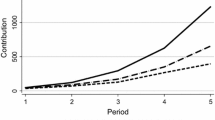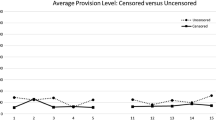Abstract
We experimentally test a model of public good bargaining due to Bowen et al. (Am Econ Rev 104:2941–2974, 2014) and compare two institutions governing bargaining over public good allocations. The setup involves two parties negotiating the distribution of a fixed endowment between a public good and each party’s individual account. Parties attach either high or low weight to the public good and the difference in these weights reflects the degree of polarization. Under discretionary bargaining rules, the status quo default allocation to the group account (in the event of disagreement) is zero while under the mandatory bargaining rule it is equal to the level last agreed upon. The mandatory rule thus creates a dynamic relationship between current decisions and future payoffs, and our experiment tests the theoretical prediction that the efficient level of public good is provided under the mandatory rule while the level of public good funding is at a sub-optimal level under the discretionary rule. Consistent with the theory, we find that proposers (particularly those attaching high weight to the public good) propose significantly greater allocations to the public good under mandatory rules than under discretionary rules and this result is strengthened with an increase in polarization. Still, public good allocations under mandatory rules fall short of steady state predictions, primarily due to fairness concerns that prevent proposers from exercising full proposer power.

Source: Congressional Budget Office Data







Similar content being viewed by others
Notes
CBO, The Budget and Economic Outlook: 2022 to 2032, May 2022, https://www.cbo.gov/publication/57950.
Our mandatory-aligned and mandatory-polarized treatments correspond to the ‘low-polarization’ and ‘high-polarization’ cases of mandatory budget rules in Bowen et al. (2014).
Under the induced logarithmic utility specification for the public good payoff, it can be easily shown that the Pareto efficient level for the public good allocation in the dynamic bargaining games described in this section is \(\theta _{H}+\theta _{L}\); see Bowen et al., (2014) Sec.II.
The experimental literature exploring Baron-Ferejohn type legislative bargaining usually involves allocation of private points only among three or more players. As noted earlier, Fréchette et al. (2012) is an exception in that they allow both public and private (particularistic) goods, similar to our study, but in a multilateral bargaining setting. While they examine static multi-stage bargaining games,their utility is linear in both the private and public goods.
Here we follow the practice recommended by Sherstyuk et al. (2013).
The two mandatory treatments, aligned or polarized, are distinguished by whether \(Y_{DO}^{*}(high)<\theta _H+\theta _L\) or not, which are named as low- or high-polarization cases, respectively, in Bowen et al. (2014).
Bowen et al. (2014), Sec.III, show that any equilibrium is payoff equivalent to the one where (i) responders accept when they are indifferent between accepting and rejecting, and (ii) the equilibrium proposals are always accepted.
Note that the predicted public good amounts (in square brackets) for the mandatory treatments in Table 2 and other tables condition on the realized status quo level of the public good at time a proposal is made, which differs by round and across sessions.
Based on the session level data in Appendix Tables B.8-B.10 for proposers and Appendix Tables B.11-B.13 for responders.
Proposed public good amounts, independent of acceptance, are also shown in Appendix Table B.14.
Also note that the three vertices of the 2-dimensional simplex in Fig. 5 represent proposals: that allocate all available resources to the group account (100, 0); that allocate all resources to the proposer’s private account (0, 100); or that allocate all resources to the responder’s private account (0, 0).
Indeed, we find that that status quo public good levels faced by low proposer types are lower than those faced by high proposer types in both mandatory treatments (e.g., this finding can be seen when Appendix Table B.19 is estimated separately for each proposer type in the two mandatory treatments).
Table B.20 in the Appendix presents an alternative version of individual efficiency where the denominator is the individual type/role’s portion of the Pareto optimal payoff. In matches between high proposers and low responders, the low types get more than their own share of Pareto optimum payoffs while the high types get less, which reflects fairness concerns but contrasts with the original efficiency measures reported in Table 10. On the other hand, in matches between low proposers and high responders, there is more ambiguity as to which type fares better in terms of relative payoffs.
References
Baranski, A., & Kagel, J. H. (2015). Communication in legislative bargaining. Journal of the Economic Science Association, 1, 59–71.
Baranski, A., & Morton, R. (2022). The determinants of multilateral bargaining: A comprehensive analysis of Baron and Ferejohn majoritarian bargaining experiments. Experimental Economics, 25(4), 1079–1108.
Baron, D. P., & Ferejohn, J. A. (1989). Bargaining in legislatures. American Political Science Review, 83(4), 1181–1206.
Battaglini, M., Nunnari, S., & Palfrey, T. R. (2012). Legislative bargaining and the dynamics of public investment. American Political Science Review, 106(2), 407–429.
Battaglini, M., & Palfrey, T. R. (2012). The dynamics of distributive politics. Economic Theory, 49, 739–777.
Bowen, T. R., Chen, Y., & Eraslan, H. (2014). Mandatory versus discretionary spending: The status quo effect. American Economic Review, 104(10), 2941–2974.
Bowen, T. R., Chen, Y., Eraslan, H., & Zápal, J. (2017). Efficiency of flexible budgetary institutions. Journal of Economic Theory, 167, 148–176.
Chen, D. L., Schonger, M., & Wickens, C. (2016). oTree-an open-source platform for laboratory, online, and field experiments. Journal of Behavioral and Experimental Finance, 9, 88–97.
Fehr, E., & Schmidt, K. M. (1999). A theory of fairness, competition, and cooperation. Quarterly Journal of Economics, 114(3), 817–868.
Fréchette, G. R., Kagel, J. H., & Lehrer, S. F. (2003). Bargaining in legislatures: An experimental investigation of open versus closed amendment rules. American Political Science Review, 97(2), 221–232.
Fréchette, G. R., Kagel, J. H., & Morelli, M. (2005a). Behavioral identification in coalitional bargaining: An experimental analysis of demand bargaining and alternating offers. Econometrica, 73(6), 1893–1937.
Fréchette, G. R., Kagel, J. H., & Morelli, M. (2005b). Gamson’s law versus non-cooperative bargaining theory. Games and Economic Behavior, 51(2), 365–390.
Fréchette, G. R., Kagel, J. H., & Morelli, M. (2005c). Nominal bargaining power, selection protocol, and discounting in legislative bargaining. Journal of Public Economics, 89(8), 1497–1517.
Fréchette, G. R., Kagel, J. H., & Morelli, M. (2012). Pork versus public goods: An experimental study of public good provision within a legislative bargaining framework. Economic Theory, 49(3), 779–800.
Fréchette, G. R., & Yuksel, S. (2017). Infinitely repeated games in the laboratory: Four perspectives on discounting and random termination. Experimental Economics, 20, 279–308.
Moffatt, P. G. (2016). Experimetrics: Econometrics for experimental economics. Macmillan: Red Globe Press.
Palfrey, T. R. (2015). Experiments in political economy. In: Kagel, J. H. and Roth, A. E., editors. Handbook of Experimental Economics, 2, 347–434.
Sherstyuk, K., Tarui, N., & Saijo, T. (2013). Payment schemes in infinite-horizon experimental games. Experimental Economics, 16, 125–153.
Author information
Authors and Affiliations
Corresponding author
Additional information
Publisher's Note
Springer Nature remains neutral with regard to jurisdictional claims in published maps and institutional affiliations.
The replication material for this project is available at: https://osf.io/3su4p/ Funding for this project was provided by the UC Irvine School of Social Sciences. The experimental protocol was approved by the UC Irvine Institutional Review Board, HS#2011-8378. Jason Ralston provided expert research assistance. We thank the Editor, Andrzej Baranski-Madrigal, and two referees for helpful comments and suggestions. Special thanks go to Renee Bowen, Ying Chen and Hülya Eraslan for sharing their Matlab code to generate Markov perfect equilibria.
Supplementary Information
Below is the link to the electronic supplementary material.
Rights and permissions
Springer Nature or its licensor (e.g. a society or other partner) holds exclusive rights to this article under a publishing agreement with the author(s) or other rightsholder(s); author self-archiving of the accepted manuscript version of this article is solely governed by the terms of such publishing agreement and applicable law.
About this article
Cite this article
Duffy, J., Kim, S. Public good bargaining under mandatory and discretionary rules: experimental evidence. Exp Econ 27, 175–214 (2024). https://doi.org/10.1007/s10683-023-09818-6
Received:
Revised:
Accepted:
Published:
Issue Date:
DOI: https://doi.org/10.1007/s10683-023-09818-6




